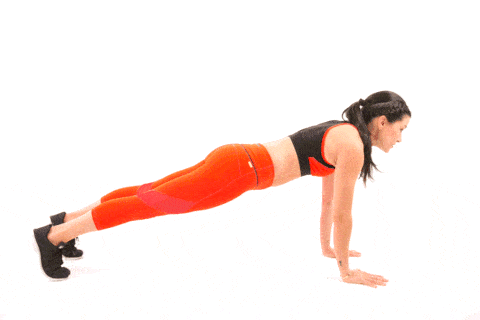I Did 90 Commando Pushups Every Day For a Week – Here Are My Results
To do this, use an isometric contraction, that is, keep the muscles in tension without lengthening or shortening (flexing or extending). It is a way to activate the muscles with less load, but there are many variations of planks to burn more muscles, using movement. Find out what happened when I did 90 pushups every day for a week and why I probably won’t do them again.
How to do the command plank

- To do a commando plank, go from a high plank position to a forearm plank and back again.
- Here you can learn how to do an up-down plank and the variations to master.
- Get into a plank position on the mat with your elbows extended, shoulders over your wrists, and hips in line with your shoulders (this is how you do a plank).
- Squeeze your stomach in and lower your left elbow to the mat below your left shoulder, followed by your right.
- Pause in a plank position on your elbows, then press your left palm into the mat, followed by your right hand.
- Switch arms each time to work your body evenly, keeping your hips in line with the mat without rocking your torso. This movement must be slow and controlled.
Unlike regular planks, commando planks or “military planks” also work your chest, arms (including your triceps), and shoulders more, and increase your heart rate. Strengthening your lower back, gluteal and hamstring muscles will improve posture and protect your spine, while building a strong core helps you lift heavier, run faster and perform better with less risk of injury.
I did 90 pushups every day for a week – here are my results
The commando plates burn the whole body. If you are a beginner, first practice holding the position for long periods of time. You can also use your knees to adjust to the movement pattern. To advance the exercise, try putting on a weighted vest or balancing on one leg.
DAY 1
I like to approach the commando plank like ripping off a Band-Aid: just do it and think about the pain afterward. I program command planks for clients regularly, so I’m used to demonstrating them and doing them myself, but maybe not 90 reps in one go.
My approach on day one was to tackle them head-on with very little rest and keep moving. This tactic worked until, around 50 reps, my shoulders started burning. At that point, I decided to add 45 seconds of rest in the middle of the week.
DAYS 2 AND 3
After the second day, my arms were feeling it, but I couldn’t feel it anywhere else, so I added a weighted vest to spice things up. I only recommend working in a weighted vest if you feel confident that you know how to do it. They’re great for toughening up bodyweight resistance exercises, but they put extra stress on your joints, especially during aerobic activity. If you have trouble with weight-bearing activities, a weight vest may not be suitable.
Personally, it helped me increase the intensity and heart rate and muscle engagement. Pushing back against the extra weight had me shaking through the remaining reps with a sweaty indignation I had no one to blame for.
DAYS 4 AND 5
90 reps of anything is a good number of reps, and while I would encourage high reps in a workout – a lot of classes adopt high-rep resistance strategies or max reps against a time limit – I wouldn’t do it for one movement. every day for a week.
By day five, it was time to focus on re-engaging my core, readjusting my form every 30 reps. We spoke with calisthenics trainer Jase Robinson in creating this calisthenics workout. He reiterated the importance of compound contraction: contracting all the muscles at once, including those in the back, belly, and buttocks.
He adds that this helps people focus on the larger muscle groups while ” subconsciously contracting all the smaller supporting muscles.” By using mindful contraction, Robinson says, you’ll also improve coordination.
DAY 6
With a day to go and 450 fewer reps, I was sore. Unilateral training is brilliant for testing and developing balance and neuromuscular coordination, but repeatedly loading one shoulder at a time, even briefly, put my weaker left shoulder muscles to the test. I removed my weight vest and spent the last two days focusing on slower movement and shoulder stability.
DAY 7
Finally came the day. I finished the last few reps at a ferocious speed and with increased vigor, reflecting on what I had learned.
I was sore, my left shoulder felt tender, and my upper body was fatigued like I just did endless pushups, but overall, it wasn’t as bad as I thought.